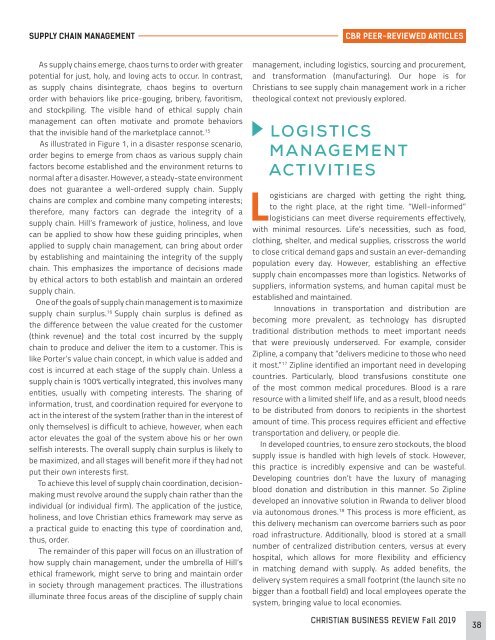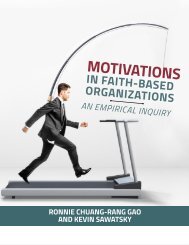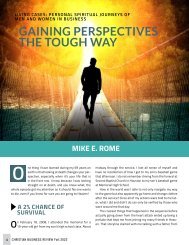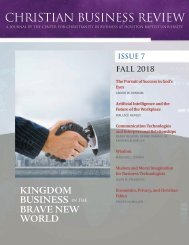Christian Business Review 2019: Workplace Practices That Glorify God (Issue 8)
You also want an ePaper? Increase the reach of your titles
YUMPU automatically turns print PDFs into web optimized ePapers that Google loves.
SUPPLY CHAIN MANAGEMENT<br />
CBR PEER-REVIEWED ARTICLES<br />
As supply chains emerge, chaos turns to order with greater<br />
potential for just, holy, and loving acts to occur. In contrast,<br />
as supply chains disintegrate, chaos begins to overturn<br />
order with behaviors like price-gouging, bribery, favoritism,<br />
and stockpiling. The visible hand of ethical supply chain<br />
management can often motivate and promote behaviors<br />
that the invisible hand of the marketplace cannot. 15<br />
As illustrated in Figure 1, in a disaster response scenario,<br />
order begins to emerge from chaos as various supply chain<br />
factors become established and the environment returns to<br />
normal after a disaster. However, a steady-state environment<br />
does not guarantee a well-ordered supply chain. Supply<br />
chains are complex and combine many competing interests;<br />
therefore, many factors can degrade the integrity of a<br />
supply chain. Hill’s framework of justice, holiness, and love<br />
can be applied to show how these guiding principles, when<br />
applied to supply chain management, can bring about order<br />
by establishing and maintaining the integrity of the supply<br />
chain. This emphasizes the importance of decisions made<br />
by ethical actors to both establish and maintain an ordered<br />
supply chain.<br />
One of the goals of supply chain management is to maximize<br />
supply chain surplus. 16 Supply chain surplus is defined as<br />
the difference between the value created for the customer<br />
(think revenue) and the total cost incurred by the supply<br />
chain to produce and deliver the item to a customer. This is<br />
like Porter’s value chain concept, in which value is added and<br />
cost is incurred at each stage of the supply chain. Unless a<br />
supply chain is 100% vertically integrated, this involves many<br />
entities, usually with competing interests. The sharing of<br />
information, trust, and coordination required for everyone to<br />
act in the interest of the system (rather than in the interest of<br />
only themselves) is difficult to achieve, however, when each<br />
actor elevates the goal of the system above his or her own<br />
selfish interests. The overall supply chain surplus is likely to<br />
be maximized, and all stages will benefit more if they had not<br />
put their own interests first.<br />
To achieve this level of supply chain coordination, decisionmaking<br />
must revolve around the supply chain rather than the<br />
individual (or individual firm). The application of the justice,<br />
holiness, and love <strong>Christian</strong> ethics framework may serve as<br />
a practical guide to enacting this type of coordination and,<br />
thus, order.<br />
The remainder of this paper will focus on an illustration of<br />
how supply chain management, under the umbrella of Hill’s<br />
ethical framework, might serve to bring and maintain order<br />
in society through management practices. The illustrations<br />
illuminate three focus areas of the discipline of supply chain<br />
management, including logistics, sourcing and procurement,<br />
and transformation (manufacturing). Our hope is for<br />
<strong>Christian</strong>s to see supply chain management work in a richer<br />
theological context not previously explored.<br />
LOGISTICS<br />
MANAGEMENT<br />
ACTIVITIES<br />
Logisticians are charged with getting the right thing,<br />
to the right place, at the right time. “Well-informed”<br />
logisticians can meet diverse requirements effectively,<br />
with minimal resources. Life’s necessities, such as food,<br />
clothing, shelter, and medical supplies, crisscross the world<br />
to close critical demand gaps and sustain an ever-demanding<br />
population every day. However, establishing an effective<br />
supply chain encompasses more than logistics. Networks of<br />
suppliers, information systems, and human capital must be<br />
established and maintained.<br />
Innovations in transportation and distribution are<br />
becoming more prevalent, as technology has disrupted<br />
traditional distribution methods to meet important needs<br />
that were previously underserved. For example, consider<br />
Zipline, a company that “delivers medicine to those who need<br />
it most.” 17 Zipline identified an important need in developing<br />
countries. Particularly, blood transfusions constitute one<br />
of the most common medical procedures. Blood is a rare<br />
resource with a limited shelf life, and as a result, blood needs<br />
to be distributed from donors to recipients in the shortest<br />
amount of time. This process requires efficient and effective<br />
transportation and delivery, or people die.<br />
In developed countries, to ensure zero stockouts, the blood<br />
supply issue is handled with high levels of stock. However,<br />
this practice is incredibly expensive and can be wasteful.<br />
Developing countries don’t have the luxury of managing<br />
blood donation and distribution in this manner. So Zipline<br />
developed an innovative solution in Rwanda to deliver blood<br />
via autonomous drones. 18 This process is more efficient, as<br />
this delivery mechanism can overcome barriers such as poor<br />
road infrastructure. Additionally, blood is stored at a small<br />
number of centralized distribution centers, versus at every<br />
hospital, which allows for more flexibility and efficiency<br />
in matching demand with supply. As added benefits, the<br />
delivery system requires a small footprint (the launch site no<br />
bigger than a football field) and local employees operate the<br />
system, bringing value to local economies.<br />
CHRISTIAN BUSINESS REVIEW Fall <strong>2019</strong><br />
38 2














